Abstract
We have used a 175-nucleotide-long primer extension product corresponding to the 5' end of HLA-DR alpha-chain mRNA to isolate a genomic clone from a human DNA library. The entire HLA-DR alpha gene is contained in two contiguous EcoRI fragments spanning about 7.5 kilobases (kb); most of the sequence has been determined. The 5' end of the gene is contained in a 4.4-kb fragment, and the coding segments and the 3' untranslated region are contained in a 3.1-kb fragment. The gene is split into five exons. The 5' untranslated region, the leader peptide, and the first two NH2-terminal amino acids are fused into the first exon. Exons 2 and 3 represent two extracellular coding domains of mature p34. The transmembrane domain, cytoplasmic domain, and part of the 3' untranslated region are merged into a fourth exon. The rest of the 3' untranslated region is in exon 5. The predicted amino acid sequence of mature p34, as deduced from its gene structure, has 229 residues and reveals a single potential disulfide loop (between cysteine residues 107 and 163) as well as a 22-amino acid residue membrane integrated segment (residues 193-214). Fifteen amino acids (residues 215-229) reside on the cytoplasmic side of the plasma membrane. There is considerable amino acid sequence homology between the second external domains of p34 and p29, as well as the immunoglobulin-like third domain of HLA-B7, and beta 2-microglobulin and the homologous constant region domains of the light and heavy chains of immunoglobulins.
Full text
PDF
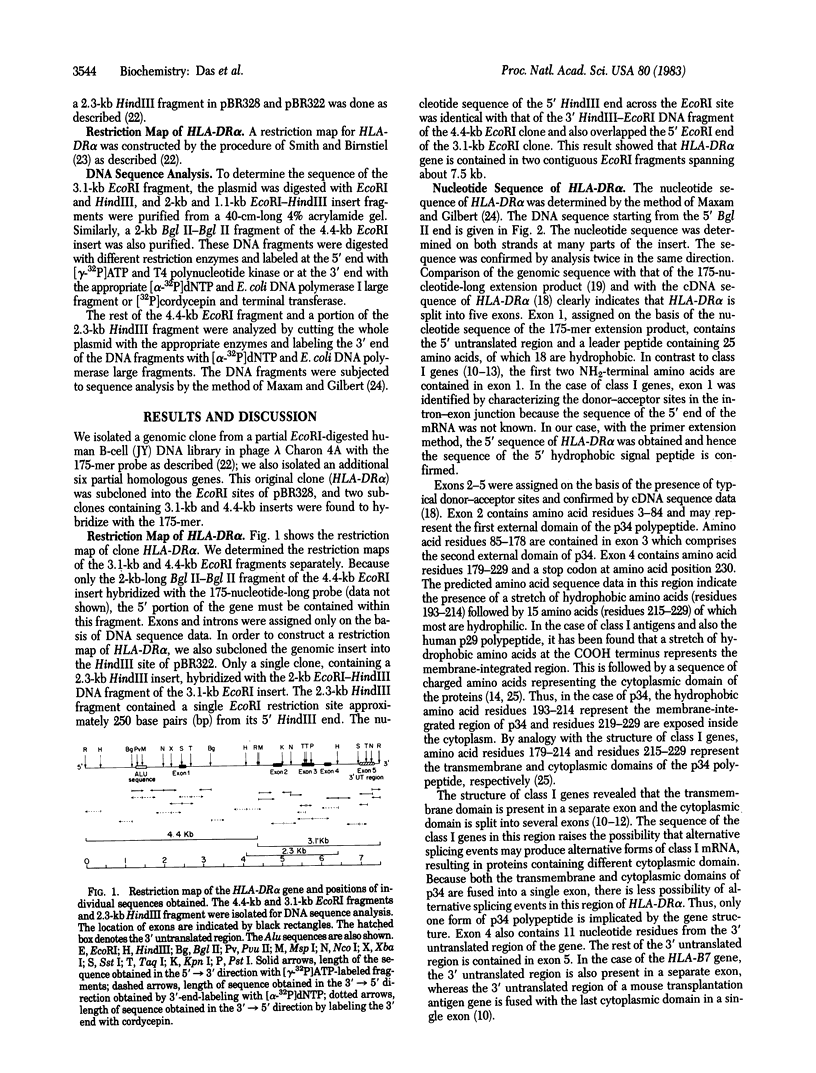
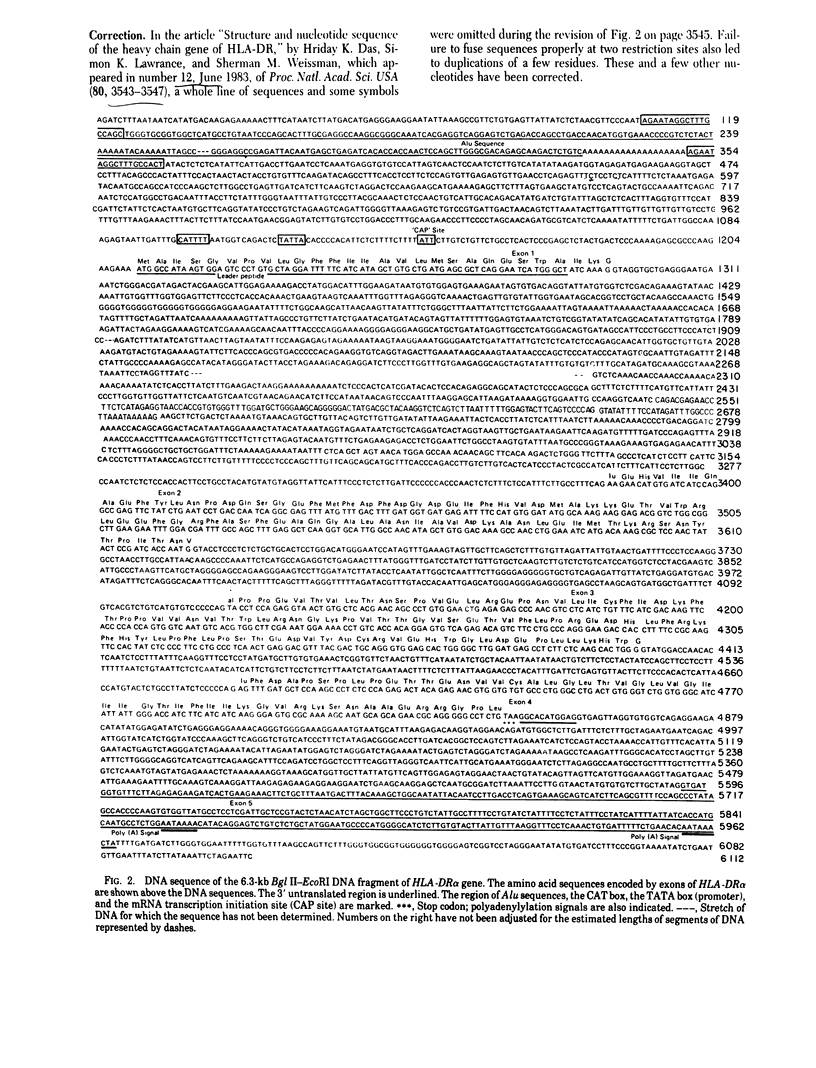
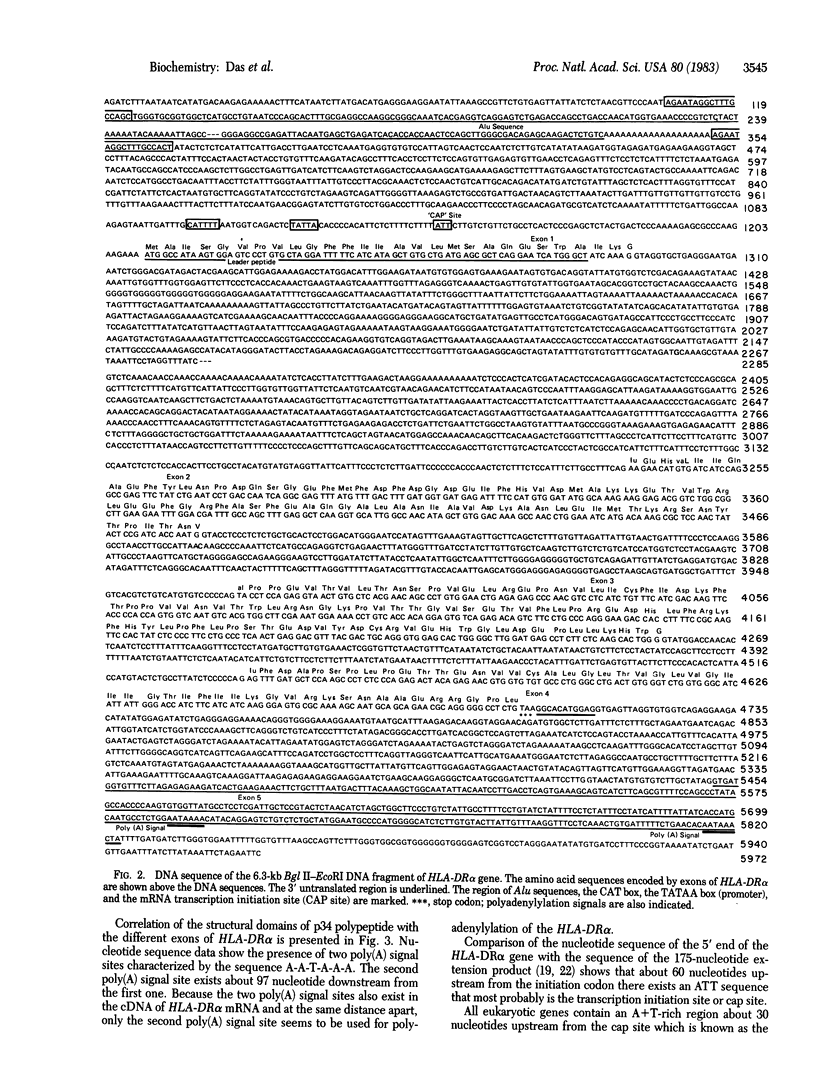
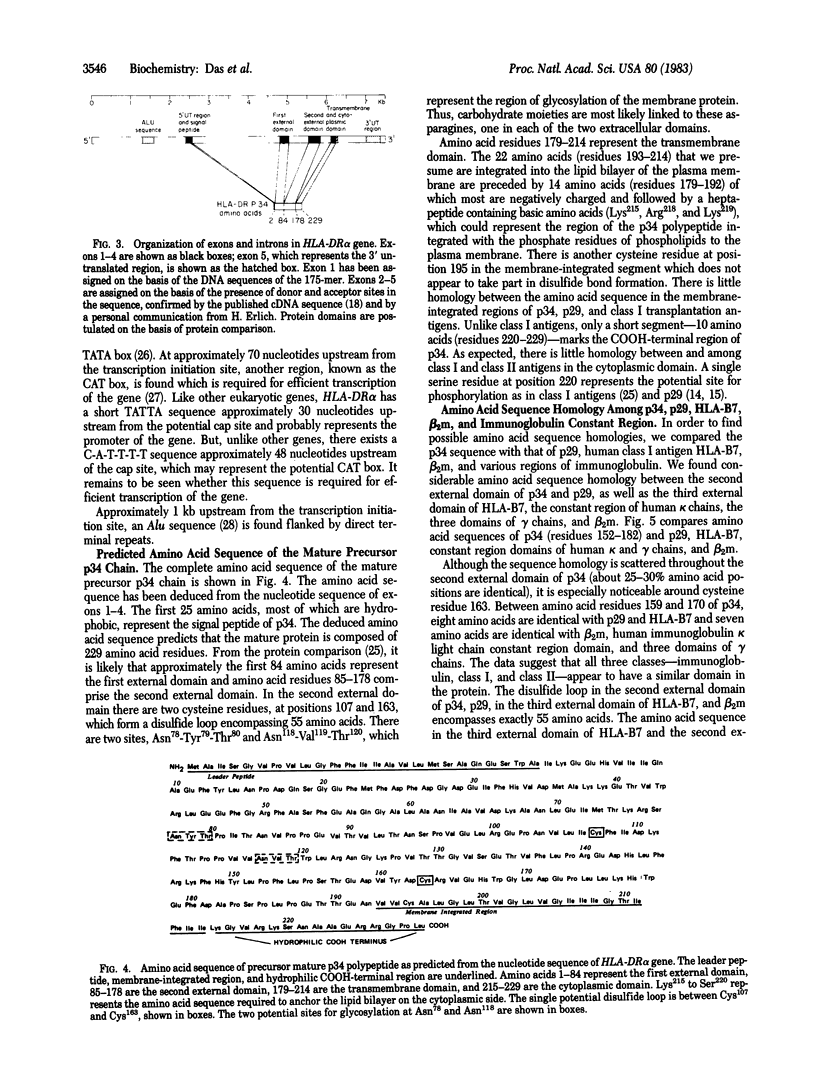
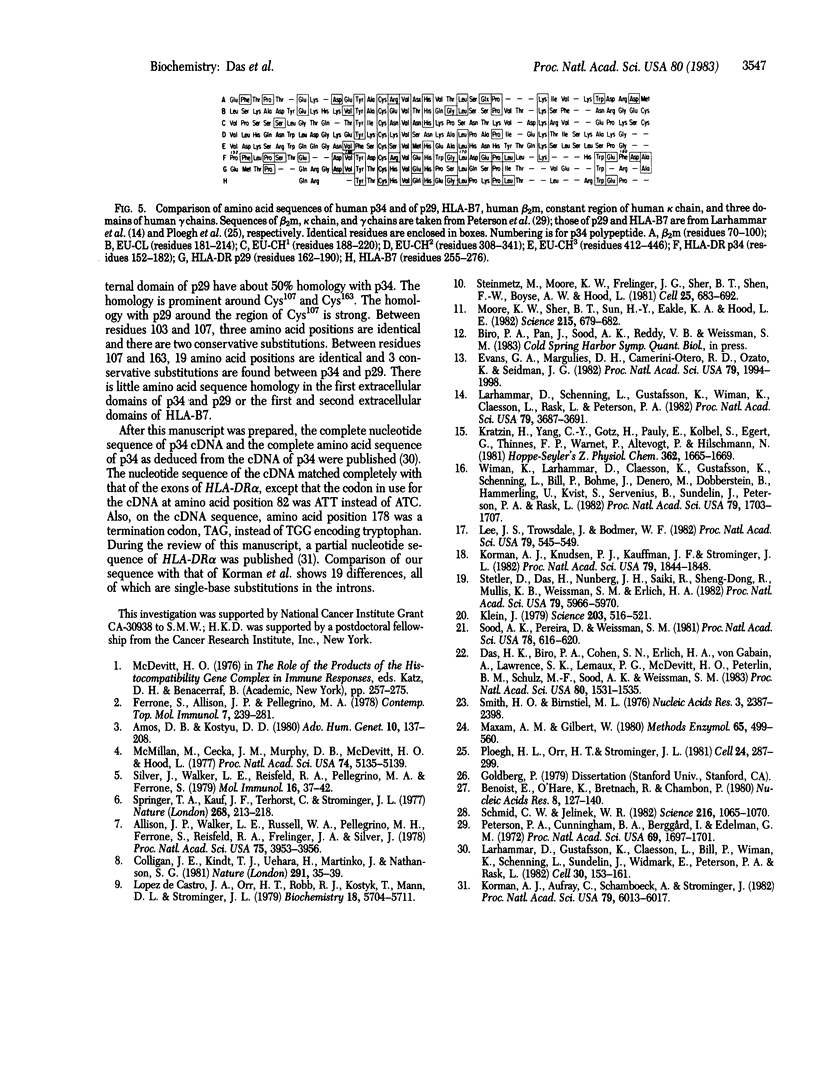
Images in this article
Selected References
These references are in PubMed. This may not be the complete list of references from this article.
- Allison J. P., Walker L. E., Russell W. A., Pellegrino M. A., Ferrone S., Reisfeld R. A., Frelinger J. A., Silver J. Murine Ia and human DR antigens: homology of amino-terminal sequences. Proc Natl Acad Sci U S A. 1978 Aug;75(8):3953–3956. doi: 10.1073/pnas.75.8.3953. [DOI] [PMC free article] [PubMed] [Google Scholar]
- Amos D. B., Kostyu D. D. HLA--a central immunological agency of man. Adv Hum Genet. 1980;10:137-208, 385-6. doi: 10.1007/978-1-4615-8288-5_2. [DOI] [PubMed] [Google Scholar]
- Benoist C., O'Hare K., Breathnach R., Chambon P. The ovalbumin gene-sequence of putative control regions. Nucleic Acids Res. 1980 Jan 11;8(1):127–142. doi: 10.1093/nar/8.1.127. [DOI] [PMC free article] [PubMed] [Google Scholar]
- Coligan J. E., Kindt T. J., Uehara H., Martinko J., Nathenson S. G. Primary structure of a murine transplantation antigen. Nature. 1981 May 7;291(5810):35–39. doi: 10.1038/291035a0. [DOI] [PubMed] [Google Scholar]
- Das H. K., Biro P. A., Cohen S. N., Erlich H. A., von Gabain A., Lawrance S. K., Lemaux P. G., McDevitt H. O., Peterlin B. M., Schulz M. F. Use of synthetic oligonucleotide probes complementary to genes for human HLA-DR alpha and beta as extension primers for the isolation of 5'-specific genomic clones. Proc Natl Acad Sci U S A. 1983 Mar;80(6):1531–1535. doi: 10.1073/pnas.80.6.1531. [DOI] [PMC free article] [PubMed] [Google Scholar]
- Evans G. A., Margulies D. H., Camerini-Otero R. D., Ozato K., Seidman J. G. Structure and expression of a mouse major histocompatibility antigen gene, H-2Ld. Proc Natl Acad Sci U S A. 1982 Mar;79(6):1994–1998. doi: 10.1073/pnas.79.6.1994. [DOI] [PMC free article] [PubMed] [Google Scholar]
- Ferrone S., Allison J. P., Pellegrino M. A. Human DR (Ia-like) antigens: biological and molecular profile. Contemp Top Mol Immunol. 1978;7:239–281. doi: 10.1007/978-1-4757-0779-3_8. [DOI] [PubMed] [Google Scholar]
- Klein J. The major histocompatibility complex of the mouse. Science. 1979 Feb 9;203(4380):516–521. doi: 10.1126/science.104386. [DOI] [PubMed] [Google Scholar]
- Korman A. J., Auffray C., Schamboeck A., Strominger J. L. The amino acid sequence and gene organization of the heavy chain of the HLA-DR antigen: homology to immunoglobulins. Proc Natl Acad Sci U S A. 1982 Oct;79(19):6013–6017. doi: 10.1073/pnas.79.19.6013. [DOI] [PMC free article] [PubMed] [Google Scholar]
- Korman A. J., Knudsen P. J., Kaufman J. F., Strominger J. L. cDNA clones for the heavy chain of HLA-DR antigens obtained after immunopurification of polysomes by monoclonal antibody. Proc Natl Acad Sci U S A. 1982 Mar;79(6):1844–1848. doi: 10.1073/pnas.79.6.1844. [DOI] [PMC free article] [PubMed] [Google Scholar]
- Kratzin H., Yang C. Y., Götz H., Pauly E., Kölbel S., Egert G., Thinnes F. P., Wernet P., Altevogt P., Hilschmann N. Primärstruktur menschlicher Histokompatibilitätsantigene der Klasse II. 1. Mitteilung: Aminosäuresequenz der N-terminalen 198 Reste der beta-Kette des HLA-Dw2,2;DR2,2-Alloantigens. Hoppe Seylers Z Physiol Chem. 1981 Dec;362(12):1665–1669. [PubMed] [Google Scholar]
- Larhammar D., Gustafsson K., Claesson L., Bill P., Wiman K., Schenning L., Sundelin J., Widmark E., Peterson P. A., Rask L. Alpha chain of HLA-DR transplantation antigens is a member of the same protein superfamily as the immunoglobulins. Cell. 1982 Aug;30(1):153–161. doi: 10.1016/0092-8674(82)90021-6. [DOI] [PubMed] [Google Scholar]
- Larhammar D., Schenning L., Gustafsson K., Wiman K., Claesson L., Rask L., Peterson P. A. Complete amino acid sequence of an HLA-DR antigen-like beta chain as predicted from the nucleotide sequence: similarities with immunoglobulins and HLA-A, -B, and -C antigens. Proc Natl Acad Sci U S A. 1982 Jun;79(12):3687–3691. doi: 10.1073/pnas.79.12.3687. [DOI] [PMC free article] [PubMed] [Google Scholar]
- Lee J. S., Trowsdale J., Bodmer W. F. cDNA clones coding for the heavy chain of human HLA-DR antigen. Proc Natl Acad Sci U S A. 1982 Jan;79(2):545–549. doi: 10.1073/pnas.79.2.545. [DOI] [PMC free article] [PubMed] [Google Scholar]
- López de Castro J. A., Orr H. T., Robb R. J., Kostyk T. G., Mann D. L., Strominger J. L. Complete amino acid sequence of a papain-solubilized human histocompatibility antigen HLA-B7. 1. Isolation and amino acid composition of fragments and of tryptic and chymotryptic peptides. Biochemistry. 1979 Dec 11;18(25):5704–5711. doi: 10.1021/bi00592a029. [DOI] [PubMed] [Google Scholar]
- Maxam A. M., Gilbert W. Sequencing end-labeled DNA with base-specific chemical cleavages. Methods Enzymol. 1980;65(1):499–560. doi: 10.1016/s0076-6879(80)65059-9. [DOI] [PubMed] [Google Scholar]
- McMillan M., Cecka J. M., Murphy D. B., McDevitt H. O., Hood L. Structure of murine Ia antigens: partial NH2-terminal amino acid sequences of products of the I-E or I-C subregion. Proc Natl Acad Sci U S A. 1977 Nov;74(11):5135–5139. doi: 10.1073/pnas.74.11.5135. [DOI] [PMC free article] [PubMed] [Google Scholar]
- Moore K. W., Sher B. T., Sun Y. H., Eakle K. A., Hood L. DNA sequence of a gene encoding a BALB/c mouse Ld transplantation antigen. Science. 1982 Feb 5;215(4533):679–682. doi: 10.1126/science.7058332. [DOI] [PubMed] [Google Scholar]
- Peterson P. A., Cunningham B. A., Berggård I., Edelman G. M. 2 -Microglobulin--a free immunoglobulin domain. Proc Natl Acad Sci U S A. 1972 Jul;69(7):1697–1701. doi: 10.1073/pnas.69.7.1697. [DOI] [PMC free article] [PubMed] [Google Scholar]
- Ploegh H. L., Orr H. T., Strominger J. L. Major histocompatibility antigens: the human (HLA-A, -B, -C) and murine (H-2K, H-2D) class I molecules. Cell. 1981 May;24(2):287–299. doi: 10.1016/0092-8674(81)90318-4. [DOI] [PubMed] [Google Scholar]
- Schmid C. W., Jelinek W. R. The Alu family of dispersed repetitive sequences. Science. 1982 Jun 4;216(4550):1065–1070. doi: 10.1126/science.6281889. [DOI] [PubMed] [Google Scholar]
- Silver J., Walker L. E., Reisfeld R. A., Pellegrino M. A., Ferrone S. Structural studies of murine I-E and human DR antigens. Mol Immunol. 1979 Jan;16(1):37–42. doi: 10.1016/0161-5890(79)90025-7. [DOI] [PubMed] [Google Scholar]
- Smith H. O., Birnstiel M. L. A simple method for DNA restriction site mapping. Nucleic Acids Res. 1976 Sep;3(9):2387–2398. doi: 10.1093/nar/3.9.2387. [DOI] [PMC free article] [PubMed] [Google Scholar]
- Sood A. K., Pereira D., Weissman S. M. Isolation and partial nucleotide sequence of a cDNA clone for human histocompatibility antigen HLA-B by use of an oligodeoxynucleotide primer. Proc Natl Acad Sci U S A. 1981 Jan;78(1):616–620. doi: 10.1073/pnas.78.1.616. [DOI] [PMC free article] [PubMed] [Google Scholar]
- Springer T. A., Kaufman J. F., Terhorst C., Strominger J. L. Purification and structural characterisation of human HLA-linked B-cell antigens. Nature. 1977 Jul 21;268(5617):213–218. doi: 10.1038/268213a0. [DOI] [PubMed] [Google Scholar]
- Steinmetz M., Moore K. W., Frelinger J. G., Sher B. T., Shen F. W., Boyse E. A., Hood L. A pseudogene homologous to mouse transplantation antigens: transplantation antigens are encoded by eight exons that correlate with protein domains. Cell. 1981 Sep;25(3):683–692. doi: 10.1016/0092-8674(81)90175-6. [DOI] [PubMed] [Google Scholar]
- Stetler D., Das H., Nunberg J. H., Saiki R., Sheng-Dong R., Mullis K. B., Weissman S. M., Erlich H. A. Isolation of a cDNA clone for the human HLA-DR antigen alpha chain by using a synthetic oligonucleotide as a hybridization probe. Proc Natl Acad Sci U S A. 1982 Oct;79(19):5966–5970. doi: 10.1073/pnas.79.19.5966. [DOI] [PMC free article] [PubMed] [Google Scholar]
- Wiman K., Larhammar D., Claesson L., Gustafsson K., Schenning L., Bill P., Böhme J., Denaro M., Dobberstein B., Hammerling U. Isolation and identification of a cDNA clone corresponding to an HLA-DR antigen beta chain. Proc Natl Acad Sci U S A. 1982 Mar;79(6):1703–1707. doi: 10.1073/pnas.79.6.1703. [DOI] [PMC free article] [PubMed] [Google Scholar]



